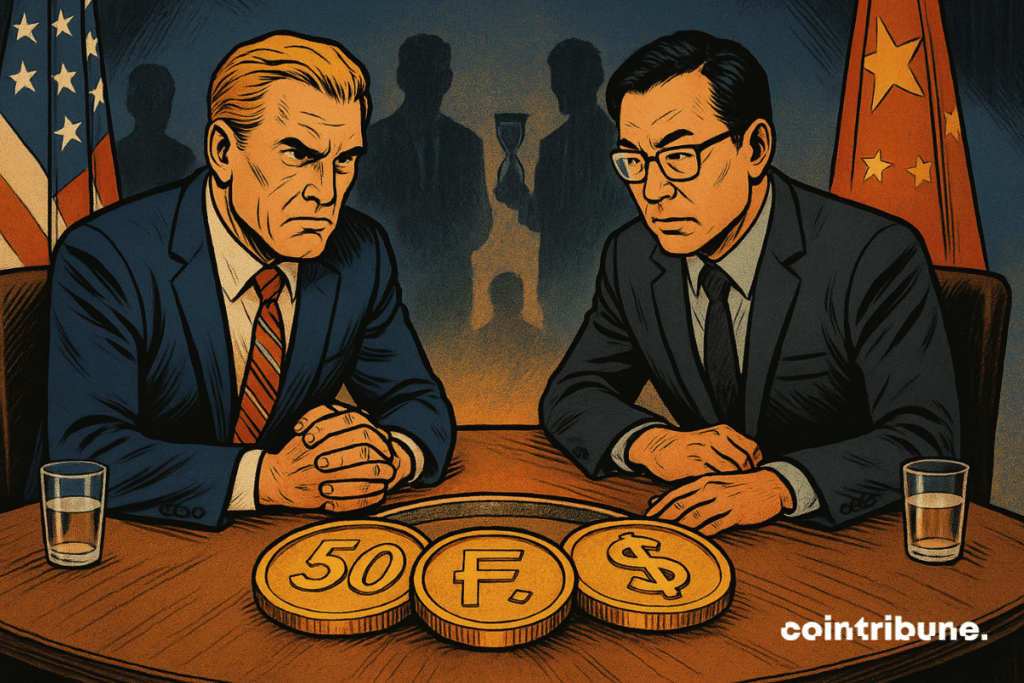China And US Discuss Easing Tech Export Restrictions
While Washington and Beijing reopen a diplomatic channel in London, tensions over rare earths and semiconductors threaten global stability. Facing the Chinese delegation, Washington shows firmness. Donald Trump, true to his style, sets the tone : “China is not easy.” Behind this phrase, a reality emerges: neither side seems willing to yield on such strategically explosive issues.

In brief
- The United States and China resumed their trade negotiations this Monday in London amid ongoing tensions.
- Donald Trump commented on the talks, stating that “China is not easy,” while also claiming to receive “good reports.”
- The American delegation, led by high-ranking officials, aims to ease certain restrictions on tech exports.
- Tuesday’s resumption of talks could either break the deadlock or escalate a strategic trade clash with global consequences.
The negotiations in London : a high-tension strategic dialogue
Trade talks between the United States and China resumed in London, at the historic Lancaster House, aiming to ease growing tensions around trade in technology and critical raw materials.
On Monday, for more than six hours, delegations from the two countries met behind closed doors. On the American side, the delegation was led by Scott Bessent (Treasury Secretary), Howard Lutnick (Commerce Minister), and Jamieson Greer (Trade Representative).
Donald Trump, interviewed at the White House on the same day, summarized the situation with a double-edged phrase: “We are doing a good job with China. China is not easy.” He also added : “I only receive good reports.”
According to initial public statements, the discussions were described as “fruitful” by Lutnick and a “good meeting” by Bessent.
The topics addressed at this meeting reflect first-rate strategic stakes for both countries. According to available information, the United States is considering easing several recent measures that aim to restrict exports of critical technologies, provided Beijing relaxes its own limitations on rare earth exports.
More specifically, Washington would be willing to lift certain restrictions imposed over the past weeks, including :
- The ban on exporting semiconductor design software ;
- Restrictions on civil-use jet engine parts ;
- Limitations concerning certain sensitive chemicals ;
- Blocks on nuclear materials used for civilian purposes.
In exchange, the United States expects China, one of the influential members of the BRICS alliance, to ease its controls on rare earth exports, of which it supplies nearly 70 % of global production.
These materials are essential in highly strategic sectors, ranging from smartphones to nuclear reactors, including military equipment and green technologies.
Conditional negotiations : de-escalation or a new phase of tensions?
Although the first day of talks ended without any official statement from the Chinese representatives, some signals were interpreted as a willingness to engage in dialogue.
He Lifeng, Vice Premier in charge of the delegation, refrained from any comment after the meeting, as did Wang Wentao, the Commerce Minister, despite being deeply involved in recent state visits by Xi Jinping.
The absence of a public statement from the Chinese side contrasts with the deliberately optimistic communication from the American side. However, no concrete announcements have yet been made regarding easing or modifying the current restrictions.
If reciprocal concessions occur, they would likely happen behind closed doors, without media fanfare. The fact that discussions resume Tuesday morning at the same place confirms that at least some common ground is being explored.
One point of friction remains the very nature of the exports targeted by U.S. restrictions: semiconductor design software, in particular, strikes at the heart of the technological competition between the two countries. In this context, every measure is perceived either as a warning shot or a gesture of openness, depending on timing and tone.
If these negotiations result in a reduction of restrictions such as the suspension of tariffs for 90 days, it could alleviate pressure on certain technology supply chains and, indirectly, stabilize segments of the digital industry. Conversely, failure would reinforce the technological decoupling already underway between the two giants. For markets, including cryptos, this could mean increased volatility, a retreat to safe haven assets, or, on the contrary, a relative calm.
Maximize your Cointribune experience with our "Read to Earn" program! For every article you read, earn points and access exclusive rewards. Sign up now and start earning benefits.
Diplômé de Sciences Po Toulouse et titulaire d'une certification consultant blockchain délivrée par Alyra, j'ai rejoint l'aventure Cointribune en 2019. Convaincu du potentiel de la blockchain pour transformer de nombreux secteurs de l'économie, j'ai pris l'engagement de sensibiliser et d'informer le grand public sur cet écosystème en constante évolution. Mon objectif est de permettre à chacun de mieux comprendre la blockchain et de saisir les opportunités qu'elle offre. Je m'efforce chaque jour de fournir une analyse objective de l'actualité, de décrypter les tendances du marché, de relayer les dernières innovations technologiques et de mettre en perspective les enjeux économiques et sociétaux de cette révolution en marche.
The views, thoughts, and opinions expressed in this article belong solely to the author, and should not be taken as investment advice. Do your own research before taking any investment decisions.